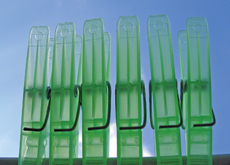Note to the reader: this column will require some work on your part. As a member of the hospitality industry, you probably receive a variety of industry publications in addition to this one. So take a look around your office and pick up a few of them.
How many of these magazines have the word "green" somewhere on the cover? My guess is at least two of the three, and probably all have at least one green article inside.
So what did we learn from this exercise? Something we already knew - green is popular. Whether it's implementing a recycling plan, linen re-use programme or seeking more environmentally friendly products, green is not only a focus, but a sweeping revolution in the hospitality market. Because of this, your guests are seeking out properties that are more eco-friendly. No doubt there is marketing value to being green. Guests appreciate staying somewhere committed to reducing its impact on the environment.
But there's an additional benefit as well. Often a greener approach will help properties cut expenses, particularly in the laundry room. However, it's up to the general manager and laundry manager to hone in on which manufacturers are offering truly green products and which ones are touting savings that are either unrealistic or flat-out untrue.
Take for instance the popular boast of water savings for washer-extractors. Plenty of marketing campaigns are centered on selling huge savings in the area of 30% up to 50% or more. Truth is, most washer-extractors only have three water settings, which makes it difficult to experience these savings and still produce good clean, quality results. The best on-premises laundries can do is choose a washer-extractor that enables the laundry manager to fine tune programmes with variable water levels. In this best-case scenario, the water savings likely will be in the area of about 10%.

Advertisement
Don't discount this 10% figure as a minimal green gain. Remember that some wash programmes are using hot water. So that means you are heating 10% less hot water. That translates into greater utility efficiency and savings.
Savings, however, don't have to stop there. Real green efficiency may have less to do with that new washer-extractor you put into service and more to do with who is programming the unit. Many operations I've seen have made a pre-wash cycle part of every wash programme. While it certainly doesn't hurt to put loads through a pre-wash, in most cases it's unnecessary and requires 15% to 25% more water. Pre-wash cycles are only required for heavy-soil loads. Your on-premises laundry could save thousands of gallons of water annually by cutting out wasteful pre-wash cycles.
Likewise, bleach bath cycles utilise 15% more water. This is another wash programme component that may not be necessary for every load your laundry processes. In addition, the property's green story gets even better when you factor in the reduced utility consumption from not having to heat those thousands of gallons (most pre-wash cycles are hot water fills).
The key to a greener approach is building in a degree of flexibility. That starts with a washer-extractor with great flexibility to tailor wash cycles, including water fill levels and G-force extraction. But to get the efficient results you desire from your operation, you must work closely with your chemical company representative. This is the person who most often is responsible for setting wash formulas.
Let's not forget the drying side of our greener laundry. Since tumblers account for 70% of all energy consumption in the laundry, it's imperative to have efficient equipment. Manufacturers with a good balance between heat, airflow and tumble action will deliver the best results. Greater drying efficiency, however, is influenced more by washer-extractors than the tumblers themselves. High G-force extraction of 300 G-force or above will significantly reduce drying times by up to 30% compared to 86 G-force units.
A total green approach in your hotel laundry will also account for how water is heated. Dated boiler units, though still operating maintenance-free, may be costing more money over the long-term to operate. Tankless water-heating systems can deliver hot water on demand and excellent efficiency to quickly offset the cost of the upgrade.
Green is most definitely in and here to stay. As a result, the list of products branded as green or helping your business green-up seems to grow exponentially each week. Therefore, it's up to hotel decision makers to carefully investigate the claims made by each manufacturer as well as the impact these features and benefits will have on their individual property. My experience has shown many hotels could make great strides toward water and energy efficiency with just a few simple changes in the laundry.
These simple changes can translate into major savings on the bottom line. But perhaps hotels will see an even greater impact from the marketing side when it can tout its green approach to prospective guests
Alliance Laundry Systems regional sales director Ghassan Majdalani serves the Middle East, Africa and Central Asia. Contact: ghassan.majdalani@alliancels.com
The truth about being green |
Next Top Stories
More BoH Stories









 Search our database of more than 2,700 industry companies
Search our database of more than 2,700 industry companies









